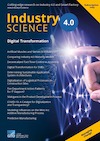Search


Bibtex
Cite as text
@Article{Gronau+Schumacher,
Cite-key = "Gronau2023Com",
Year= "2023",
Number= "1",
Volume= "Industry 4.0 Science 39",
Pages= "16-33",
Journal = "Industry 4.0 Science",
Title= "Comparing Industry 4.0 Maturity Models",
Author= "Norbert Gronau, University of Potsdam, Jochen Schumacher, MPDV",
Doi= "https://doi.org/10.30844/I4SE.23.1.16",
Abstract= "In recent years, numerous maturity models have been developed with the aim of providing a clear indication of the progress each company has made in terms of Industry 4.0 development. However, not all models include all
aspects of Industry 4.0. The models are also not equally practical. This article offers an in-depth comparison and assessment of the comprehensiveness of the ten most important Industry 4.0 maturity models.",
Keywords= "Industry 4.0, Maturity models, maturity model comparison, smart factory, smart supply chain, smart products, digital product mapping, product lifecycle, reallife applicability of maturity models,
management, corporate culture, maturity index, maturity models for SMEs, CPS, cyber-physical systems",
}
Norbert Gronau, University of Potsdam, Jochen Schumacher, MPDV(2023): Comparing Industry 4.0 Maturity Models. Industry 4.0 Science 391(2023), S. 16-33. Online: https://doi.org/10.30844/I4SE.23.1.16 (Abgerufen 15.12.25)
Open Access
Abstract
Abstract
In recent years, numerous maturity models have been developed with the aim of providing a clear indication of the progress each company has made in terms of Industry 4.0 development. However, not all models include all aspects of Industry 4.0. The models are also not equally practical. This article offers an in-depth comparison and assessment of the comprehensiveness of the ten most important Industry 4.0 maturity models.
Keywords
Schlüsselwörter
Industry 4.0, Maturity models, maturity model comparison, smart factory, smart supply chain, smart products, digital product mapping, product lifecycle, reallife applicability of maturity models, management, corporate culture, maturity index, maturity models for SMEs, CPS, cyber-physical systems
References
Referenzen
[1] Angreani, L. S.; Vijaya, A.; Wicaksono, H.: 2020. Systematic Literature Review of Industry 4.0 Maturity Model for Manufacturing and Logistics Sectors. Procedia Manufacturing, Band 52, pp. 337-343.
[2] Appelfeller, W.; Feldmann, C.: 2018. Die digitale Transformation des Unternehmens. Systematischer Leitfaden mit zehn Elementen zur Strukturierung und Reifegradmessung. Berlin: Springer Gabler.
[3] Dommermuth, M.: 2021. Entwicklung und Anwendung eines konsekutiven integralen Transformationskonzeptes für Werke von Industrieunternehmen mit variantenreicher Fertigung zur Analyse, Planung, Umsetzung und Kontrolle von Industrie 4.0. Berlin: Springer.
[4] Ehemann, T. et al.: 2021. Mit dem InAsPro-Transformationskonzept die Digitalisierung planen. In: W. Bauer, et al. Hrsg. Arbeit in der digitalisierten Welt. Berlin Heidelberg: Springer Vieweg, pp. 205- 222.
[5] Heppner, H.; Schlicher, K.; Hobscheidt, D.: 2019. INLUMIA – Instrumentarium zur Steigerung der Leistungsfähigkeit durch Industrie 4.0. In: GfA, Hrsg. Frühjahrskongress 2019. Arbeit interdisziplinär analysieren – bewerten – gestalten C.3.7. Dortmund: GfA.
[6] Hübner, M.: 2018. Das Industrie 4.0-Reifegradmodell. In: G. Lanza & P. Nyhuis, Hrsg. Industrie 4.0 für die Praxis. Befähigungs- und Einführungsstrategien. Garbsen: TEWISS, pp. 184-196.
Kese, D.; Terstegen, S.: 2017. Benchmark Reifegradmodelle. IEE Industrie Engineering Effizienz, 10, pp. 30-34.
[7] Knackstedt, R.; Pöppelbuß, J. & Becker, J.: 2009. Vorgehensmodell zur Entwicklung von Reife- gradmodellen. Wien, Österreichische Computer Gesellschaft, pp. 535-544.
Lichtblau, K. et al.: 2015. Industrie 4.0-Readiness (gefördert von der IMPULS-Stiftung des VDMA), Aachen, Köln: Institut der deutschen Wirtschaft Köln Consult GmbH.
[8] Matt, D. T. et al.: 2018. Industrie 4.0 Assessment – Bewertungsmodell zur Identifikation und Priori- sierung von Industrie 4.0 Umsetzungsmaßnahmen in KMUs. In: D. T. Matt, Hrsg. KMU 4.0 – Digitale Transformation in kleinen und mittelständischen Unternehmen. Schriftenreihe der WGAB. Berlin: GITO, pp. 93-112.
[9] Müller, E.; Tawalbeh, M.; Hopf, H.: 2018. Reifegradbestimmung als Vorstufe der Industrie 4.0-Strategieentwicklung. In: D. T. Matt, Hrsg. KMU 4.0 – Digitale Transformation in kleinen und mittelständischen Unternehmen. Schriftenreihe der WGAB.. Berlin: GITO, pp. 71-91.
[10] Pierenkemper, C.; Reinhold, J.; Dumitrescu, R.; Gausemeier, J.: 2019. Erfolg versprechende Industrie 4.0-Zielposition. Ermittlung unter Berücksichtigung zukünftiger Umfeldentwicklungen. Industrie 4.0 Management, 5, Issue 35, pp. 30-34.
[11] Puchan, J.; Zeifang, A.: 2017. Industrie-4.0-Reifegradmodell. In: T. Barton, et al. Hrsg. Angewandte Forschung in der Wirtschaftsinformatik. Prozesse, Technologie, Anwendungen, Systeme und Management. Tagungsband zur 30. AKWI-Jahrestagung. Heide: mana-Buch, pp. 257-265.
[12] Schuh, G. et al.: 2017. Industrie 4.0 Maturity Index. Die digitale Transformation von Unternehmen steuern (acatech STUDIE). München: Herbert Utz. Schuh, G. et al., 2018. Industrie 4.0: Implement it! – Ein Leitfaden zur erfolgreichen Implementierung von Industrie 4.0-Lösungen. Aachen: s.n.
[13] Schumacher, A.; Erol, S.; Sihn, W.: 2016. A maturity model for assessing Industry 4.0 readiness and maturity of manufacturing enterprises. Procedia CIRP, Band 52, pp. 161-166.
[14] VDMA, F. I. 4. (ed): 2017. Leitfaden Industrie 4.0 Orientierungshilfe zur Einführung in den Mittelstand. Frankfurt: VDMA Verlag GmbH.

 English
English